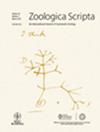A phylogeographic analysis of the North American medicinal leech, Macrobdella decora (Say, 1824)
IF 2
2区 生物学
Q2 EVOLUTIONARY BIOLOGY
引用次数: 0
Abstract
In spite of their important roles in many ecosystems, data regarding population structure and biogeographic patterns of leeches are scarce. To begin to address this knowledge gap, we herein perform a phylogeographic analysis of the North American medicinal leech,北美药用水蛭 Macrobdella decora(Say,1824 年)的系统地理学分析
尽管水蛭在许多生态系统中发挥着重要作用,但有关水蛭种群结构和生物地理格局的数据却很少。为了填补这一知识空白,我们在本文中对北美药用水蛭Macrobdella decora(Say,1824 年)进行了系统地理学分析。我们从横跨美国和加拿大大片地区的 35 个地点共采集了 224 份 M. decora 标本,涵盖了该物种的大部分已知分布区。利用四个基因位点(线粒体细胞色素 c 氧化酶亚单位 I [COI] 和 NADH 脱氢酶 I [ND1],以及核 18S rRNA [18S] 和 28S rRNA [28S]),我们采用几种最优化标准构建了系统发生树,并将地理模式叠加到树上,以找出种群之间的潜在结构。令人惊讶的是,由于该物种的地理范围很大,而且存在大量潜在的基因流动地理障碍,分析结果显示 M. decora 不同种群之间明显缺乏结构。不过,AMOVA 确实显示了种群内和种群间遗传变异的显著统计学差异(COI:FST = 0.65412,p <;.00001;ND1:FST = 0.69245,p <;.00001),这在很大程度上是由 35 个种群中的 6 个种群造成的,并表明存在跨越阿巴拉契亚山脉扩散的潜在障碍。最后,Mantel 检验表明,地理距离与遗传距离之间存在微弱但显著的相关性(COI:r = 0.209,p = .027;ND1:r = 0.1289,p = .030);然而,这种相关性主要由单一地点驱动。总体上的弱结构表明,M. decora 在其整个分布区都是泛食性的,我们根据之前对食血和非食血物种的种群水平研究对此进行了讨论,得出结论认为,M. decora 缺乏结构可能是由于其通过宿主进行扩散的能力很强。
本文章由计算机程序翻译,如有差异,请以英文原文为准。
求助全文
约1分钟内获得全文
求助全文
来源期刊

Zoologica Scripta
生物-动物学
CiteScore
5.60
自引率
0.00%
发文量
52
审稿时长
>12 weeks
期刊介绍:
Zoologica Scripta publishes papers in animal systematics and phylogeny, i.e. studies of evolutionary relationships among taxa, and the origin and evolution of biological diversity. Papers can also deal with ecological interactions and geographic distributions (phylogeography) if the results are placed in a wider phylogenetic/systematic/evolutionary context. Zoologica Scripta encourages papers on the development of methods for all aspects of phylogenetic inference and biological nomenclature/classification.
Articles published in Zoologica Scripta must be original and present either theoretical or empirical studies of interest to a broad audience in systematics and phylogeny. Purely taxonomic papers, like species descriptions without being placed in a wider systematic/phylogenetic context, will not be considered.
 求助内容:
求助内容: 应助结果提醒方式:
应助结果提醒方式:


